Alocasia black velvet is an attractive plant known for its magnificent dark green leaves with a luxurious velvety texture. Yet, despite its admiration, many owners have encountered the same concern—curling leaves in Alocasia black velvet.
It is a common problem for this houseplant and can be caused by various environmental factors or improper care.
If you are experiencing the same problem, don’t worry!
Today, we are going to discuss all the potential causes and solutions behind the curling of Alocasia black velvet leaves.
So, without further ado, let us get started!

Why Is My Alocasia Black Velvet Leaves Curling?
As a common houseplant, Alocasia will comfortably grow in general household conditions. Still, you might face some problems while growing this botanical beauty—the curling leaves is one of them.
Let us discuss all the potential reasons behind this!
1. Underwatering and Overwatering
Alocasia is a tropical plant that requires consistent moisture to survive.
You can say that proper watering and moisture regulation are vital aspects of the Alocasia care routine. If they don’t get enough water their leaves may curl up because the plant cannot take up enough water for its needs.
But, if you are giving too much water, the leaves curl up the same way as the plant tries to prevent water loss.
Not only that, but an overwatered plant can also show much more serious consequences than the curled leaves and in some cases can cause death of the plant due to root rot.
2. Overfertilization
Fertilizing your Alocasia can really boost its growth and help it grow to its full potential. But remember that Alocasia black velvet is not a heavy feeder. Therefore, excessive fertilization can actually stress out your plant.
If notice that the leaves start to curl, it might be a sign that you are feeding your plant with too many nutrients. The salts in the fertilizer burn the root system due to which the plant growth is affected.
During the growing season, it is recommended to fertilize your plant about once a month. This way, you will avoid excessive fertilization which can lead to nutrient burn and other problems.
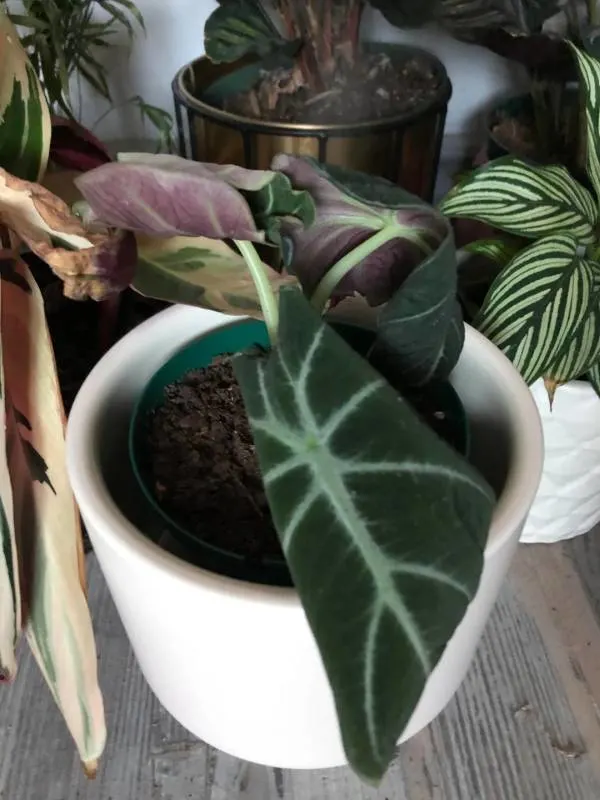
3. Insect and Pest Infestation
Pests that feed on plant fluids like mealybugs, spider mites, and aphids can cause curled Alocasia leaves by damaging the plant cells. Not only do these pests suck out the plant’s juices but also, they lay eggs which leads to further infestation and damage.
Pro Tip: It is suggested to examine your plant from time to time for any pest indication, such as webbing or tiny insects, and take immediate action in case of any attack.
4. Temperature and Humidity
Temperature changes can cause the leaves to curl up due to temperature stress. Whether it’s cold drafts or hot temperatures, both extremes can contribute to Alocasia leaves curling.
To avoid this, keep the plant in a consistent temperature between 59°F and 80°F.
If we talk about humidity, black velvet needs a humid environment. Low humidity causes the black velvet leaves to curl up due to a lack of moisture within the plant cell.
To counter this, the air around Alocasia must be moist enough to prevent the water within plant cells from evaporating. The preferable levels of humidity are between 60–75%.
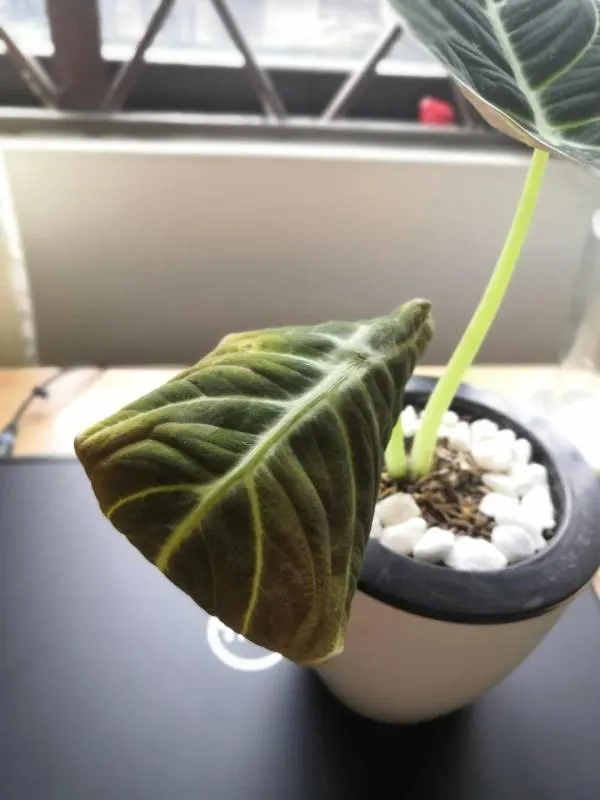
5. Too Much or Too Little Light
Just like all the other factors we have discussed, too much or too little light can cause the leaves to curl.
Alocasia is tropical plants that prefer to grow in bright, indirect sunlight. However, excessive light can be harmful. When exposed to too much light, these plants become overactive and generate more energy that the plant cannot handle, leading to the curling of leaves.
Contrarily, if there is too little light, the plant will not produce enough energy—and in the same way, leading to the curling of leaves.
How to Fix Curled Alocasia Leaves?
I hope you understand all the reasons behind the curling of Alocasia black velvet leaves. Now let’s discuss how you can fix those leaves and bring your plant’s beauty back to normal.
1. Finding the Root Cause of Alocasia Leaves Curling
First, check for the root cause of Alocasia curling leaves.
Begin by inspecting the environment—take note of the amount of light, water, humidity, and temperature.
If any of these factors are insufficient or excessive, adjust them accordingly.
Similarly look out for any pest or insect that could infest your plant.
Taking the time to check for the root cause helps you to cure the problem in an effective way.
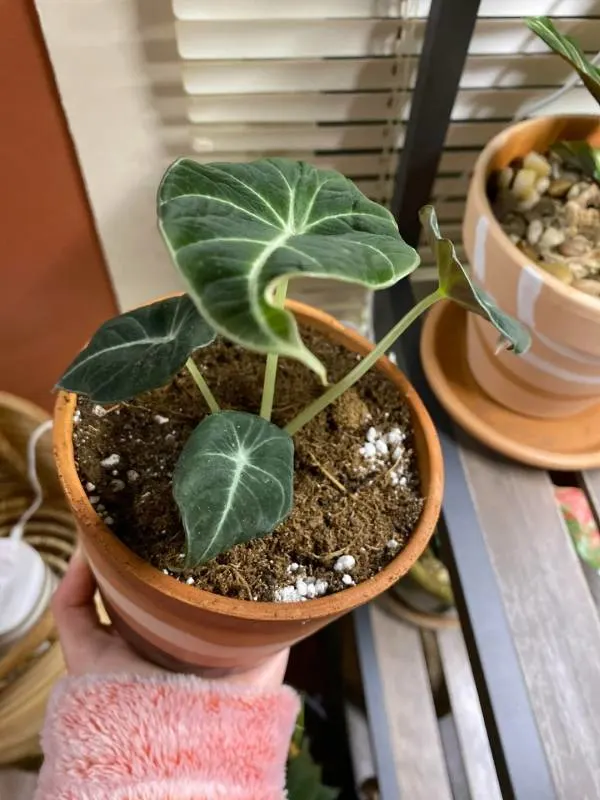
2. Provide Optimal Watering Routine
If the leaves are curling due to either underwatering or overwatering, adjust your watering schedule accordingly.
Water the plant only when the top inch of the soil feels dry.
This will help in preventing further damage to the plant and allow its roots to recover.
3. Increase Humidity
Remember to keep the humidity at least 50–60% to keep your Alocasia healthy and free from curled leaves.
If your plant is suffering due to low humidity, you can enhance it by misting Alocasia with water or using a humidifier nearby. You can also group your Alocasia plant with some other moisture-loving plants to keep the humidity levels high in the surroundings.
That will help keep the air around the Alocasia plant moist enough for growth.
4. Optimize Lighting
To adjust the lighting of your Alocasia plant, choose the spot where it receives bright, indirect sunlight for about 6 to 8 hours a day. The ideal place for your black velvet would be an east or west-facing window.
These spots will provide the ideal bright light.
But remember always place your plant one foot away from the window to prevent intense sunlight.
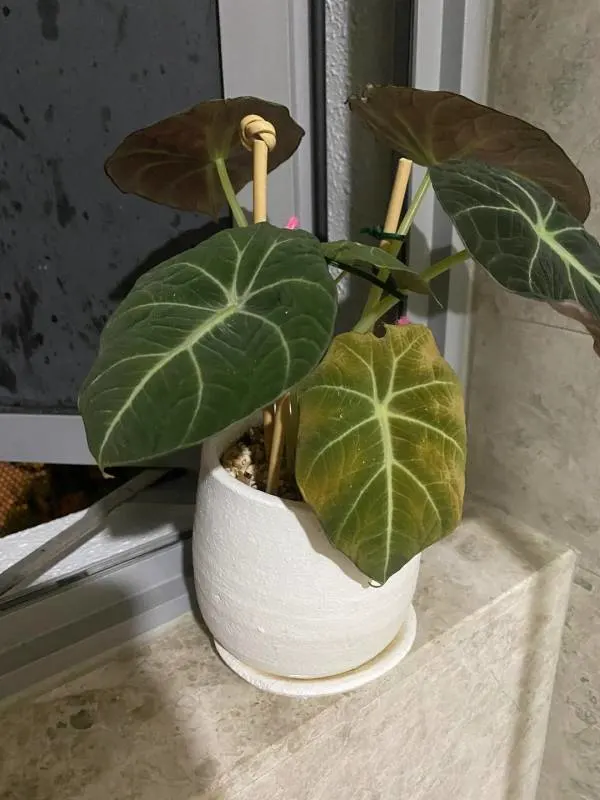
5. Fix Overfertilization
If you have overfertilized your Alocasia, you can flush the soil with water to remove excess salt. Repeat this process multiple times to get rid of all the salts.
Another effective approach is to carefully scrap the layer of soil to remove any excess fertilizer.
Moving forward, it is advisable to use a houseplant fertilizer and apply it once a month during the growing season. However, avoid fertilizing the plant during winter to prevent over-fertilization.
6. Provide an Appropriate Temperature Range
Alocasia prefers temperature ranges between 68 and 86°F and cannot survive below 50°F.
If your plant is living in an environment where there is a low or higher temperature than the average requirements, consider changing its position to prevent leaves from curling.
Look for a warmer room or provide extra warmth during cold weather and vice versa.
7. Treat Any Pest Infestation
If you don’t find any factor absent, there must be some pest infestations.
Upon noticing any pest, you need to take immediate action. Remove any visible pests using a cotton swab dipped in rubbing alcohol to prevent the spread of infection.
Then you can use insecticidal soap or neem oil to spray the plant and remove any affected leaves or stems.
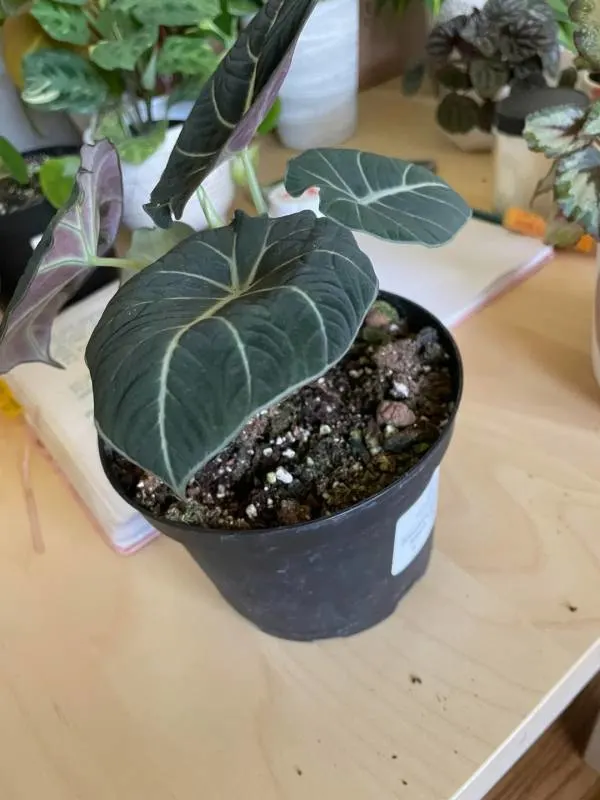
That’s all for today!
Now it’s time to move toward the conclusion.
Conclusion
The curling of Alocasia leaves can be attributed to various factors such as improper watering, pest infestations, and inadequate light exposure.
The first step is to understand the root cause to find the best cure. By adjusting all the environmental factors and treating pest infestations—in case your plant has any, you can help your plant grow healthy and wealthy.
I hope this post helps you a lot!
If you have any questions regarding plants, you can mention them in the comment section below.
